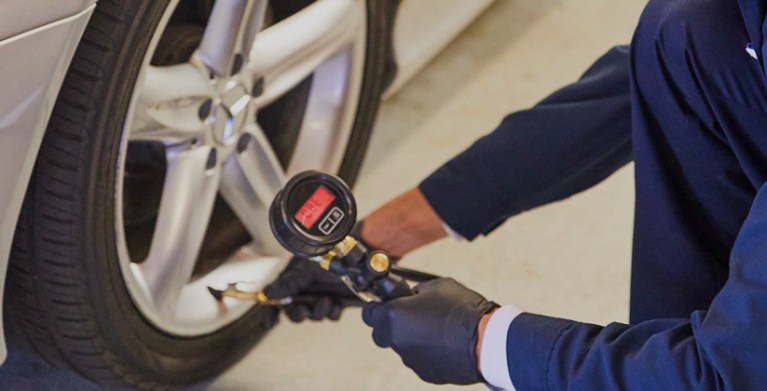Maintain Rolling Smoothly: GMC Tires Service by Morris Tires
Maintain Rolling Smoothly: GMC Tires Service by Morris Tires
Blog Article
Tire Solution: The Effect of Weather
When it comes to making sure optimum efficiency and safety on the roadway, comprehending the impact of climate problems on tire solution is vital. GMC Tire Service. In this conversation, we will check out the intricate relationship in between weather conditions and tire solution, dropping light on the importance of weather-specific tire maintenance practices and factors to consider.
Heat and Tire Performance
When revealed to high temperature levels, tires experience changes in efficiency that can significantly impact vehicle safety and handling. The warm produced from prolonged driving or heat conditions triggers the tire rubber to soften, resulting in minimized tread life and enhanced wear. As the rubber ends up being softer, the tire's grasp when traveling diminishes, influencing stopping ranges and general traction. In extreme cases, excessive heat can even create tire blowouts, presenting a severe safety threat to the car and its passengers.

Cold Weather Condition Effects
Cold weather problems can have a significant impact on tire efficiency and safety and security. In cool weather, tires might also lose air stress more quickly, which can influence dealing with and fuel efficiency.
To minimize the results of chilly weather on tires, it is critical to on a regular basis examine tire stress and inflate them to the producer's suggested degrees. Utilizing winter or all-season tires developed for winter problems can additionally boost traction and grip on icy or snowy roads. Proper tire maintenance, including routine evaluations for wear and damages, comes to be a lot more important throughout chillier months to make certain optimal efficiency and security.
Rainy Issues Impact
Tires with worn-out treads are a lot more susceptible to hydroplaning, where a layer of water develops up in between the roadway and the tire surface, leading to loss of grip. To battle this, drivers should frequently inspect their tires for appropriate step deepness and think about spending in tires particularly designed for damp problems.
Moreover, stormy climate can likewise lower exposure, making it challenging for drivers to see the road ahead plainly (GMC Tire Service). In such problems, it is necessary to adjust driving speeds accordingly and keep a risk-free following distance to permit unexpected stops. Correctly inflated tires can additionally help in keeping control on damp roads by supplying better handling and hold
Snow and Tire Safety And Security
When driving in snowy conditions, having the ideal tires can make a substantial difference in safety and performance. Winter tires are designed with special rubber substances and walk patterns to provide much better traction on snow and ice contrasted to all-season tires.
Moreover, chauffeurs should take into consideration setting up tire chains in severe snowy conditions. Tire chains offer added traction by clutching the snow and ice, enhancing stability and control. It is important to adhere to producer guidelines when making use of and mounting tire chains to avoid damages to the tires and car (GMC Tire Service). By selecting useful site the right tires, keeping appropriate inflation, and taking into consideration extra traction help like tire chains, vehicle drivers can enhance their safety when browsing snow-covered roads.
Weather-Related Tire Upkeep
When faced with numerous climate condition, correct tire maintenance comes to be an important aspect of automobile safety and security and efficiency. Weather-related tire upkeep incorporates an array of techniques aimed at ensuring optimum tire feature and durability in different climate scenarios. One essential element of weather-related tire maintenance is tire stress guideline. Changing temperatures can trigger tire pressure Visit This Link to vary, influencing traction and fuel efficiency. On a regular basis readjusting and checking tire pressure according to maker suggestions is necessary for safe driving in transforming weather condition conditions. Additionally, tire step depth plays a considerable duty in taking care of various weather condition elements. Tires with sufficient tread deepness offer far better grasp on damp or icy roadways, decreasing the risk of skidding or hydroplaning. When tread wear reaches a particular depth is vital for maintaining traction and security in damaging weather condition, evaluating tire walk on a regular basis and changing tires. By focusing on published here weather-related tire maintenance, drivers can boost safety and security, enhance car performance, and lengthen the life expectancy of their tires.
Verdict
Finally, weather problems have a considerable influence on tire performance and safety and security. From warmth impacting tire pressure and wear to winter lowering grip, it is necessary to take into consideration the weather condition when preserving and utilizing tires. Rainy conditions can lower hold and bring about hydroplaning, while snow can raise the danger of accidents if tires are not correctly geared up. Weather-related tire maintenance is crucial in making certain optimum efficiency and safety and security on the roadways.
In this conversation, we will discover the complex relationship between weather condition conditions and tire service, dropping light on the relevance of weather-specific tire upkeep techniques and considerations.

Report this page